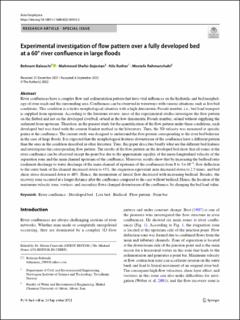| dc.description.abstract | River confluences have a complex flow and sedimentation pattern that have vital influences on the hydraulic and bed morphology of river reach and the surrounding area. Confluences can be observed in waterways with various situations such as live bed conditions. This condition is a hydro-morphological situation with a high densimetric Froude number, i.e., bed load transport is supplied from upstream. According to the literature review, most of the experimental studies investigate the flow pattern on the flatbed and not on the developed riverbed, or/and in the low densimetric Froude number, or/and without supplying the sediment from upstream. Therefore, in the present study for the quantification of the flow pattern under these conditions, each developed bed was fixed with the cement blanket method in the laboratory. Then, the 3D velocity was measured at specific points at the confluence. The current study was designed to understand the flow pattern corresponding to the river bed behavior in the case of large floods. It is expected that the morphological features downstream of the confluence have a different pattern than the ones in the condition described in other literature. Thus, this paper describes briefly what are the different bed features and investigates the corresponding flow pattern. The results of the flow pattern on the developed bed show that all zones at the river confluence can be observed except the point bar due to the approximate equality of the mean longitudinal velocity of the separation zone and the main channel upstream of the confluence. Moreover, results show that by increasing the bedload ratio (sediment discharge to water discharge of the main channel of upstream of the confluence) from 0 to 3 × 10−4, flow deflection to the outer bank of the channel decreased down to 45%, the stagnation equivalent area decreased down to 2.5 times, and bed shear stress decreased down to 40%. Hence, the momentum of lateral flow decreased with increasing bedload. Besides, the recovery zone occurred at a longer distance after the confluence compared to the case without bedload. Hence, the location of the maximum velocity zone, vortices, and secondary flows changed downstream of the confluence, by changing the bed load value. | en_US |

